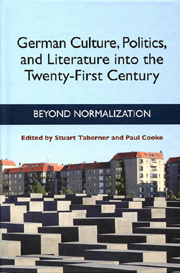Book contents
- Frontmatter
- Contents
- Acknowledgments
- Introduction
- 1 “Normalization”: Has Helmut Kohl's Vision Been Realized?
- 2 Coping with Disparity: Continuity and Discontinuity in Economic Policy since Unification
- 3 Understanding Germany: The Limits of “Normalization” and the Prevalence of Strategic Culture
- 4 “Normalization” through Europeanization: The Role of the Holocaust
- 5 “Representing Normality”: Architecture in Berlin
- 6 “Normalizing” the Past: East German Culture and Ostalgie
- 7 National Memory's Schlüsselkinder: Migration, Pedagogy, and German Remembrance Culture
- 8 The Return of “Undead” History: The West German Terrorist as Vampire and the Problem of “Normalizing” the Past in Margarethe von Trotta's Die bleierne Zeit (1981) and Christian Petzold's Die innere Sicherheit (2001)
- 9 “Normalizing” the “Old” Federal Republic? The FRG between 1949 and 1989 in Recent German Fiction
- 10 Reconciliation between the Generations: The Image of the Ordinary German Soldier in Dieter Wellershoff's Der Ernstfall and Ulla Hahn's Unscharfe Bilder
- 11 “(un)sägliche Vergleiche”: What Germans Remembered (and Forgot) in Former Yugoslavia in the 1990s
- 12 “Normal” as “Apolitical”: Uwe Timm's Rot and Thomas Brussig's Leben bis Männer
- 13 “Narrative Normalization” and Günter Grass's Im Krebsgang
- 14 From “Normalization” to Globalization. German Fiction into the New Millennium: Christian Kracht, Ingo Schulze, and Feridun Zaimoğlu
- 15 Abnormal Consensus? The New Internationalism of German Cinema
- Notes on the Contributors
- Index
6 - “Normalizing” the Past: East German Culture and Ostalgie
Published online by Cambridge University Press: 05 February 2013
- Frontmatter
- Contents
- Acknowledgments
- Introduction
- 1 “Normalization”: Has Helmut Kohl's Vision Been Realized?
- 2 Coping with Disparity: Continuity and Discontinuity in Economic Policy since Unification
- 3 Understanding Germany: The Limits of “Normalization” and the Prevalence of Strategic Culture
- 4 “Normalization” through Europeanization: The Role of the Holocaust
- 5 “Representing Normality”: Architecture in Berlin
- 6 “Normalizing” the Past: East German Culture and Ostalgie
- 7 National Memory's Schlüsselkinder: Migration, Pedagogy, and German Remembrance Culture
- 8 The Return of “Undead” History: The West German Terrorist as Vampire and the Problem of “Normalizing” the Past in Margarethe von Trotta's Die bleierne Zeit (1981) and Christian Petzold's Die innere Sicherheit (2001)
- 9 “Normalizing” the “Old” Federal Republic? The FRG between 1949 and 1989 in Recent German Fiction
- 10 Reconciliation between the Generations: The Image of the Ordinary German Soldier in Dieter Wellershoff's Der Ernstfall and Ulla Hahn's Unscharfe Bilder
- 11 “(un)sägliche Vergleiche”: What Germans Remembered (and Forgot) in Former Yugoslavia in the 1990s
- 12 “Normal” as “Apolitical”: Uwe Timm's Rot and Thomas Brussig's Leben bis Männer
- 13 “Narrative Normalization” and Günter Grass's Im Krebsgang
- 14 From “Normalization” to Globalization. German Fiction into the New Millennium: Christian Kracht, Ingo Schulze, and Feridun Zaimoğlu
- 15 Abnormal Consensus? The New Internationalism of German Cinema
- Notes on the Contributors
- Index
Summary
Over thirteen years after the fall of the Berlin Wall, united Germany became engulfed by a wave of Ostalgie: nostalgia for the former GDR. In the aftermath of Wolfgang Becker's internationally acclaimed box-office hit Good Bye, Lenin! in 2003, not only were plans for a GDR theme park unveiled, but popular Ostalgie publications swamped bookstores, internet sites such as OssiVersand and Ossiladen expanded exponentially, and shops scattered throughout Berlin, but also as far afield as Munich and Stuttgart, now offer a wide range of products, from Zetti chocolate bars to T-shirts sporting SED slogans, Ost Rock compilation CDs and Ampelmännchen cookie-cutters. Those seeking evening entertainment today may choose to have a drink in one of Berlin's several Ostalgie bars, stay at home to watch a range of GDR TV shows, or invite friends round for a glass of Rotkäppchen and a game of Überholen ohne Einzuholen. Few could argue with Matthias Platzeck, Minister President of Brandenburg and now chairman of the SPD, in his assessment that “Der Osten ist ‘angesagt.’ ” Many, however, take issue with his view that “Die neue Neugier auf die eigene Geschichte ist ein ermutigendes Zeichen — ein Beleg dafür, dass unser Land an Normalität gewinnt.” Indeed, it seems ironic that at a time when political discourse in Germany is increasingly promoting the concept of “normality,” popular culture is celebrating aspects of this nation's divided, and in many ways “abnormal,” past. This chapter examines the relationship between popular cultural manifestations of Ostalgie and the concept of normality over a decade after the fall of the Berlin Wall.
- Type
- Chapter
- Information
- German Culture, Politics, and Literature into the Twenty-First CenturyBeyond Normalization, pp. 89 - 104Publisher: Boydell & BrewerPrint publication year: 2006

